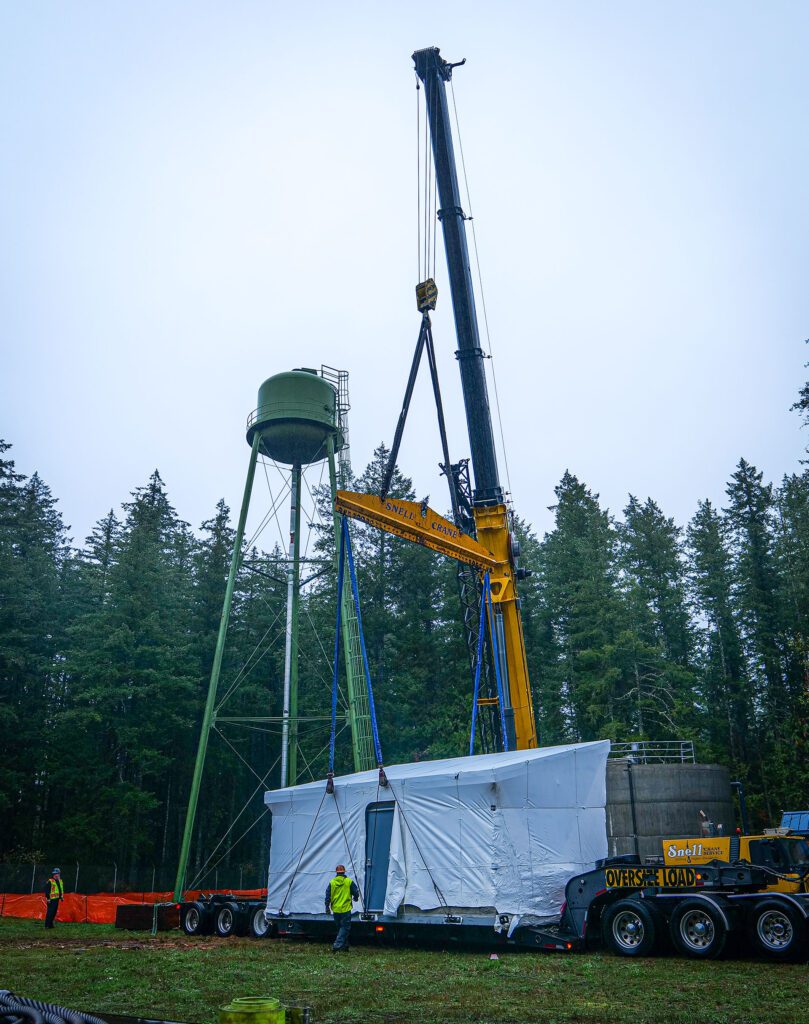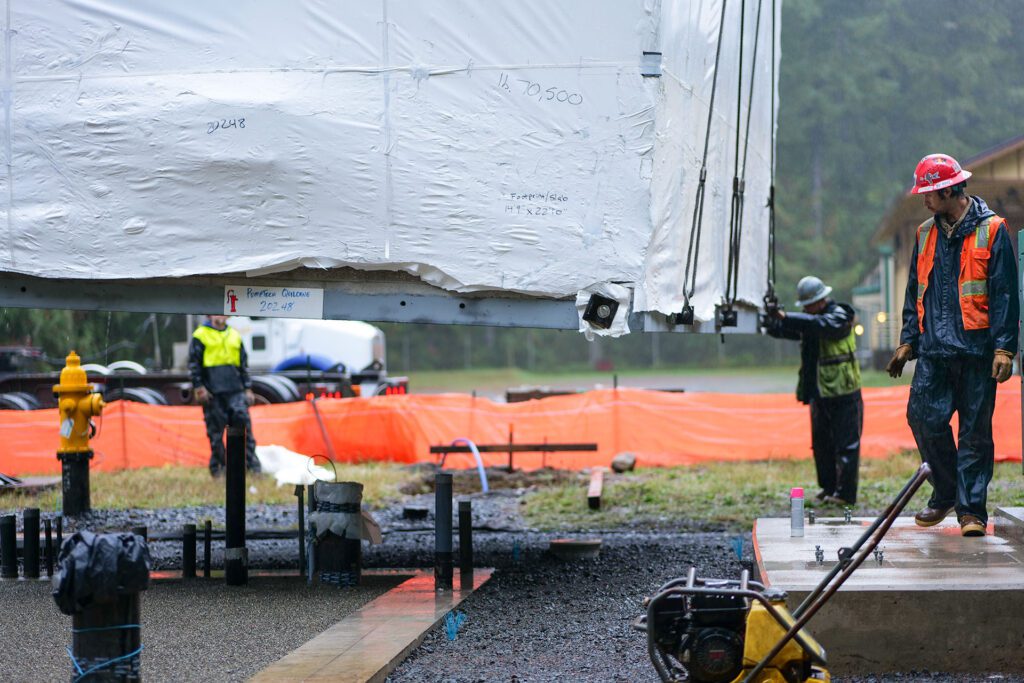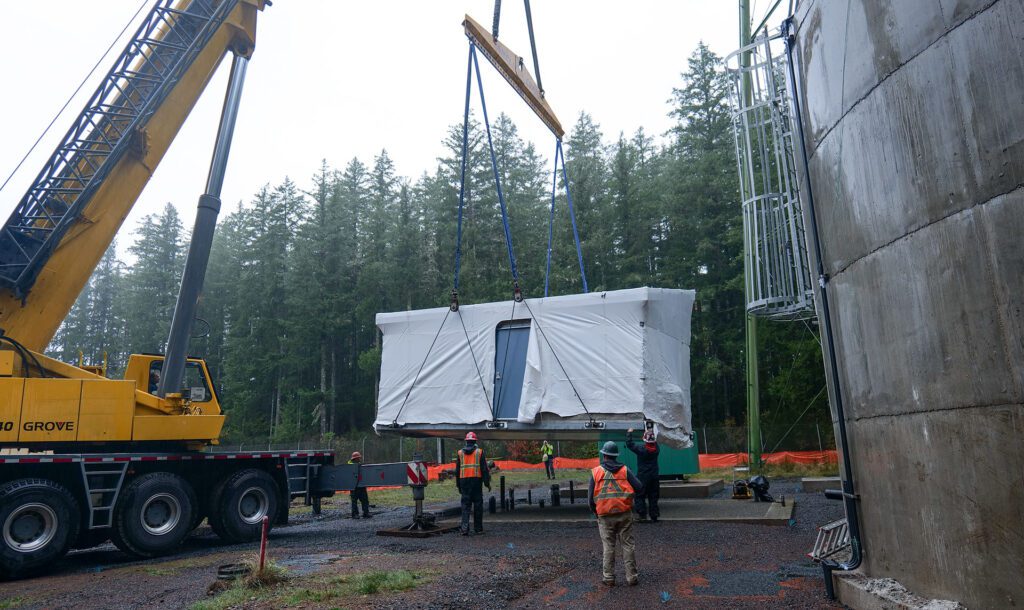Quilcene Gets a Needed (Water) Boost
With a slight twirl of his finger, the crewman signaled it was time to lift.
Massive crane cable groaned, coming tight over the pulleys. The reinforced concrete structure shifted on its trailer which let out an audible creak in relief. Hard to blame it, having traveled from northcentral Oregon shouldering a structure weighing as much as five elephants to its destination outside Quilcene.
 Slowly, carefully the seismically reinforced building weighing-in at 70,500lbs maneuvered into place.
Slowly, carefully the seismically reinforced building weighing-in at 70,500lbs maneuvered into place.
The approximately 15-foot by 23-foot building came complete with pump systems, conduit, and control systems pre-engineered and installed offsite. Its final home is the intersection between Quilcene’s new 105,000-gallon concrete water tank and its existing water main.
Looming beside the pumphouse, the massive concrete water tank replaces the aging gravity-fed, 33,000-gallon steel water tank currently supplying Quilcene customers. The larger tank and booster pumps mean commercial fire flow capability for the first time.
Seattle-based BHC Consultants completed engineering of the pumphouse. BHC provides engineering for civil projects including drinking water, wastewater, stormwater and more.
Several factors made the premanufactured building attractive, according to John Frech, BHC Project Manager and Senior Engineer. “The PUD had success with a similar building on a past project and was interested in this approach,” he said. Frech noted the building size matched well with pump sizes and control systems. Another BHC project in Clallam County recently used a similar premanufactured approach for a 3-building water system upgrade.
From design to delivery, the prefabricated structure took 14 months.
What is a booster pump?
 Booster pumps are installed to a water distribution system to help provide water pressure required for general use or expanding systems, or simply for fire flow capacity.
Booster pumps are installed to a water distribution system to help provide water pressure required for general use or expanding systems, or simply for fire flow capacity.
A booster pump system can replace the need for an elevated water tank, providing pressures equal to or far greater. Quilcene’s elevated water tank is more than 100′ tall which is needed to provide pressure to local home services.
So, what’s inside?
Inside the concrete structure are three 30hp fire flow pumps and three 5hp domestic flow pumps.
Each 30hp pump can provide up to 610 gallons per minute (gpm) of fire flow. The system is designed for two pumps operating in tandem to provide ~1,100gpm – meeting commercial fire flow standards. The remaining pump acts as a backup.
The 5 HP pumps provide water to homes and businesses for domestic uses. Each pump can deliver up to 115gpm. Like the fire flow pumps, two domestic pumps handle daily usage for customers, with one acting as backup. Actual usage in the Quilcene system requires only one pump to meet peak hour flow, with remaining pumps ready if future flows grow past 100gpm.
Water, water everywhere
 Think of water usage in your home. A toilet flush here, some dishwashing there–perhaps a load of laundry in the evening. Now consider usage on a scale of 30, perhaps 40 customers all at varying times, all tied into the same system. How do you manage flow to maintain consistent pressure?
Think of water usage in your home. A toilet flush here, some dishwashing there–perhaps a load of laundry in the evening. Now consider usage on a scale of 30, perhaps 40 customers all at varying times, all tied into the same system. How do you manage flow to maintain consistent pressure?
That’s where the designed controls come into play.
The pumphouse has the horsepower to handle the workload and, thanks to proper design engineering, pressure sensors and transmitters on the discharge side providing real-time signals to help modulate the pump speed to maintain a relatively constant pressure over a range of flows and demand.
Built in pressure gauges also allow PUD operators to quickly see how the pumps are performing.
Final connection and pump testing for the Quilcene water system is underway. Transition from the current elevated tank to the ground-based tank will occur after testing, followed by removal of the metal tank.